| Article ID | Journal | Published Year | Pages | File Type |
|---|---|---|---|---|
| 4926713 | Renewable Energy | 2017 | 14 Pages |
Abstract
Opportunities of future hydropower developments in Asia comes with challenges of handling sediments in rivers. Hard minerals in flow causes turbine parts to erode with several undesirable effects. In Francis turbines, sediment erosion causes an increase of clearance gap between guide vane walls and cover plates. Due to inherit pressure difference between guide vane surfaces, a leakage flow arises from the clearance gap. A guide vane cascade is developed to study the characteristics of the leakage flow in a low specific speed Francis turbine. Velocity and pressure measurements are done at 80% of BEP flow as that in a reference prototype turbine. Cases with five different sizes of clearance gaps are investigated. Strong cross-wise jet-like leakage flow is observed from the clearance gap. A vortex filament developed due to mixing of leakage flow with the main flow is found to hit the hub at runner inlet. The existence of a critical clearance gap size for which the leakage velocity and its effects are maximum is revealed. Interpretations of the experimental results show a close match with the observations of eroded turbine parts from a power plant.
Related Topics
Physical Sciences and Engineering
Energy
Renewable Energy, Sustainability and the Environment
Authors
Biraj Singh Thapa, Ole Gunnar Dahlhaug, Bhola Thapa,
